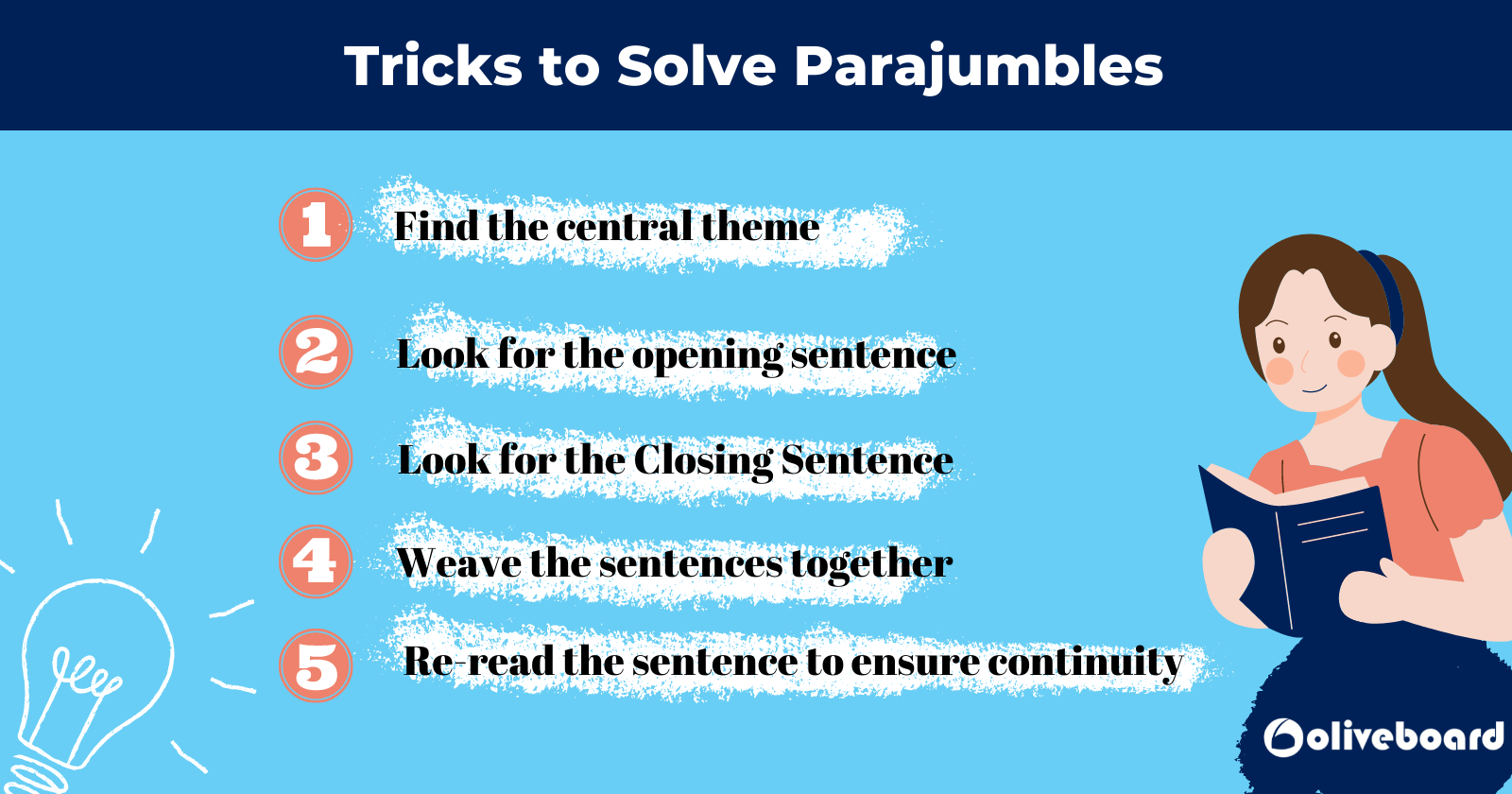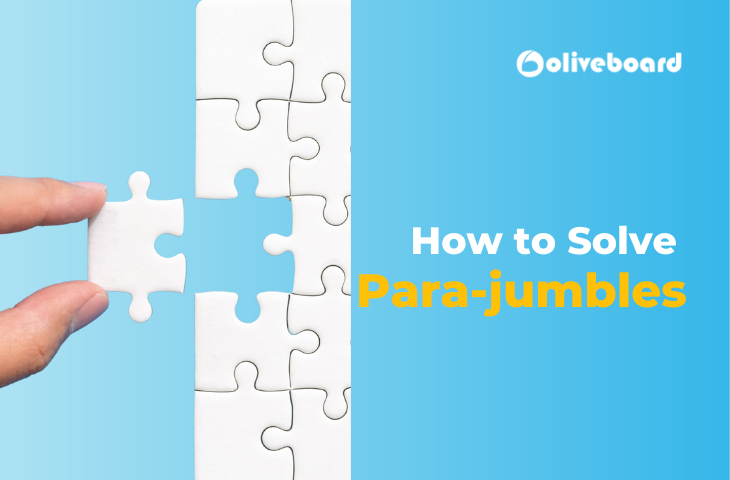Parajumbles
Parajumbles, also called jumbled sentences or sentence rearrangement, are a common question type in language and competitive exams like UGC NET, SSC, Bank, and other government tests. In a parajumble question, you’ll be given a group of sentences that are mixed up. Your job is to arrange them in the correct order so they form a clear and meaningful paragraph. There is usually no fixed time or event order in the sentences. You need to figure out how the ideas are connected and arrange them in a way that makes sense. Parajumbles for CAT, Banking, SSC and Defence Exams check how well you understand the following things:
- The meaning of the sentences
- The connection between ideas
- The flow of thoughts in writing
This skill is very helpful not just in exams, but also in writing good paragraphs and essays. To solve a parajumble question effectively, it’s essential to identify transitional words and phrases, contextual clues, and logical relationships between sentences. Practice and familiarity with various types of sentence structures and writing styles can be beneficial in mastering the art of solving parajumbles.
Parajumbles Meaning
Parajumbles are a common type of question in the English section of many competitive exams like SSC, Banking, CAT, CDS, and AFCAT, just like Reading Comprehension and Cloze Tests. In recent bank exams, you can expect around 5 to 6 parajumble questions. Some students find these questions confusing because the sentences are all mixed up, and the paragraph feels long and hard to understand. If you also find parajumbles tricky don’t worry, you’re not alone, and we’re here to help! Parajumbles, if solved properly, can help you score good marks in the English section. In this blog, we’ve explained simple steps to answer parajumble questions easily. Just follow them carefully, and the next time you face a parajumble in your exam, you’ll be able to solve it with confidence and clarity.
Parajumbles for CAT
Parajumbles are an important part of the CAT (Common Admission Test) English section. They test your understanding of sentence structure and logical flow. In these questions, you are given a few sentences in a random order, and you have to rearrange them to form a clear and meaningful paragraph.
To solve them correctly, you need good reading, reasoning, and observation skills. Regular practice is key to getting better at parajumbles in CAT.
- You will be given 4 to 5 jumbled sentences in each question.
- Your task is to rearrange them into a proper paragraph.
- Look for linking words, pronouns, or logical connectors like “however”, “therefore”, etc.
- Understand the main idea and how the sentences relate to each other.
- No options are provided in CAT parajumbles (TITA – Type In The Answer), so logic is very important.
- Regular practice helps you improve speed, accuracy, and confidence.
- Solving parajumbles improves both your comprehension skills and writing clarity – which is useful beyond CAT as well.
Parajumbles for Bank Exams
Parajumbles are an important part of the English section in bank exams like IBPS PO, SBI Clerk, and RBI Assistant. In these questions, sentences are given in a mixed-up order, and you need to rearrange them to form a clear and meaningful paragraph. These questions test your understanding of sentence flow, grammar, and logical thinking.
- Parajumbles check your language skills, logic, and reading ability.
- You need to find the correct order of sentences using context and meaning.
- Look for transitional words like “however”, “moreover”, “therefore”, etc.
- Identify the opening sentence it usually introduces the topic.
- Understand how sentences are connected and how ideas flow.
- These questions improve your reading comprehension and writing clarity.
- Regular practice helps you solve them faster and with better accuracy.
- Scoring well in parajumbles can boost your overall marks in the English section.

First of all, what are “Parajumbles” that we are talking about. So, let us know a little more about Parajumbles.
Types of Parajumbles
Parajumble questions can appear in different formats depending on the exam. Sometimes you’re given a clue like the first or last sentence, and sometimes you have to figure out everything yourself. Knowing the types can help you approach them better in the exam.
- Opening Sentence Given:
The first sentence is fixed. You have to arrange the remaining ones in the correct order. - Closing Sentence Given:
The last sentence is fixed. Use this clue to arrange the rest of the sentences logically. - Both Opening and Closing Sentences Given:
These are usually the easiest. Only the middle sentences need to be rearranged. - No Sentence Given:
Neither the first nor last sentence is fixed. You have to identify both yourself. These are the most difficult and need more practice.
How to Solve Parajumbles
Many students ask, “How can I solve parajumbles quickly and correctly?” The key is to understand the flow of the passage and how the sentences connect with each other. Follow this easy approach to solve parajumble questions with more confidence:
- Read all the sentences carefully to understand the main idea or theme.
- Identify the opening and/or closing sentence, if possible.
- Look for sentences that connect well, like a story or explanation.
- Find mandatory pairs – two sentences that clearly go together.
- Watch for transition words like however, therefore, also, but, etc. – they help show the sentence flow.
Step 1: Identify the Central Theme
Start by reading all the sentences quickly to understand the main idea. This central theme will help you figure out how the sentences should connect.
- Scan the sentences for a common subject or topic.
- Find out what the passage is mostly talking about.
- This theme helps guide the correct sentence order.
Step 2: Spot the Opening and Closing Sentences
Once the theme is clear, look for the first and last sentences. Identifying these two anchors helps significantly in positioning the remaining sentences correctly.
- Opening sentence introduces a new idea, person, place, or situation. It usually doesn’t begin with a pronoun.
- Closing sentence wraps up the idea. It often starts with transition words like “therefore”, “thus”, or “hence”.
Example:
- She was waiting for her train.
- Geeta was at the railway station.
- She was going back home on a vacation.
Correct order: 2, 1, 3
Step 3: Arrange Remaining Sentences Using Clues
After establishing the opening and closing lines, use different clues in the sentences to place the middle parts logically.
Activities and Chronological Clues
When sentences describe actions or routines, look for time-based sequencing or activities occurring in order.
- Identify keywords like “morning”, “after”, “evening” to order actions.
- Arrange sentences to reflect a natural flow of events.
Example:
- She sells cupcakes throughout the day.
- She has her dinner at 8 and sleeps at 11.
- Maria has a cupcake business.
- She makes the cupcakes in the morning.
Correct order: 3, 4, 1, 2
Abbreviations and Full Forms
The sentence that introduces a full form should come before those using abbreviations.
Example:
- The CPU carries out the instructions.
- The Central Processing Unit (CPU) is important.
- CPUs are considered the brain of a computer.
Correct order: 2, 1, 3
Ideas and Examples
General statements or ideas are always followed by examples. Look out for sentences starting with “like”, “such as”, etc.
Example:
- Like the continental shelf and slope.
- The ocean floor is divided into many parts.
Correct order: 2, 1
Connectors and Transition Words
Sentences beginning with words like “because”, “although”, “however” are usually not introductory. These indicate logical continuation from a previous sentence.
- Avoid placing them at the beginning unless they refer back to the main subject already introduced.
Use of Articles
Articles can help determine sequence:
- “A/An” is often used to introduce something.
- “The” refers to something already mentioned.
Example:
- The girl had long hair.
- There was a girl in a tower.
- And the tower was hidden.
Correct order: 2, 1, 3
Pronouns
Sentences with “he”, “she”, “it”, “they” cannot be first. They refer to someone/something already introduced.
Example:
- Ajay is a good singer.
- He has learned music for 12 years.
Correct order: 1, 2
Adjectives (Comparatives)
Comparative words like “better”, “more” indicate sequence.
Example:
- Rahul’s performance was good.
- Ashok’s performance was better.
- Both danced on the same song.
Correct order: 3, 1, 2
Time Sequence Indicators
Words such as “before”, “after”, “when”, and time indicators like “at 8pm” help arrange events chronologically.
Example:
- Hemant eats dinner at 8pm.
- After that, he does homework.
- Post-homework, he watches TV.
Correct order: 1, 2, 3
Elimination Method
Use this when you are unsure. Once the first and last sentence are identified, remove options that don’t match that sequence.
Example:
- Ramesh is hardworking.
- He sells newspapers in the morning.
- He teaches in the evening.
- He works as an assistant in the afternoon.
Opening: Sentence 1 Closing: Sentence 3
Eliminate any option that doesn’t begin with 1 or end with 3.
Step 4: Re-read to Check Flow and Continuity
After arranging all the sentences:
- Read the paragraph again.
- Make sure it flows logically.
- Check for grammatical correctness.
A well-arranged parajumble should read like a smooth, meaningful paragraph.
How to Solve Parajumbles – Tips
- If the given sentences are too lengthy, and you’re running out of time, be vigilant and pay attention to keywords like transition words, pronouns, adjectives and articles to solve it quickly.
- Notice sentences in paragraphs of novels and newspapers, notice how they are weaved together and how the words used to connect the sentences and conclude the paragraphs.
- Read a variety of text to prepare yourself for any kind of passage.
- Improve your vocabulary. Learn new words every day and use them in your conversations. Being thorough in grammar and vocabulary will go a long way in helping you solve Parajumbles.
We hope the above information on how to solve Parajumbles helps you briefly understand what Parajumbles are.
Parajumbles – Frequently Asked Questions
Ans. Parajumbles are jumbled sentences that need to be arranged to form a meaningful paragraph.
Ans. Parajumbles are asked in SSC, Banking, CAT, UGC NET, and other government exams.
Ans. Around 5–6 parajumble questions appear in the English section of bank exams.
Ans. Practice regularly using mock tests, previous year papers, and reading exercises.
Ans. Yes, types include fixed opening/closing sentence, both fixed, and none fixed.
- RRB ALP Vs RRB JE, Which is Better Job?
- Central Bank of India Apprentice Exam Date 2025 Out
- SSC CHSL English Syllabus 2025, Check Detailed Syllabus
- SSC GD Constable Exam News & Next Notification Update
- SBI PO Handwritten Declaration 2025, Format, Image Size
- Biology MCQs for SSC CGL, Get Solved Questions with Answers

Hello, I’m a content writer working at Oliveboard. I focus on creating blogs, articles, and educational content that’s simple, clear, and saves time for readers. I believe in writing that adds real value without overcomplicating things. I also have strong knowledge of banking and government exams, which helps me create content that is both accurate and easy to understand. With experience and consistency, I aim to make preparation smoother for every learner.
